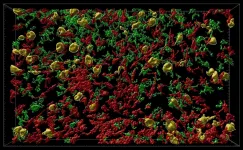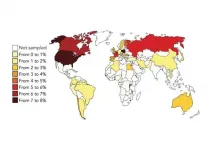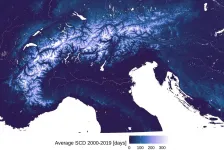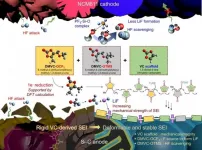Cellular Chinese whispers
How translation errors impact phenotypic variability
2021-03-18
(Press-News.org) The immense diversity in the living world and how it came into being has always been a subject of human enquiry. After centuries of playing detective in search of the basis of the parities and disparities that we see among living beings around us, the past century stood witness to some marvellous discoveries in biology and today the Central Dogma of life has been disclosed to us: DNA makes RNA and RNA makes protein (a facile view of a much more complex sequence of events). Together with contributing environmental factors, proteome(s) (total protein content of a cell) collectively influence 'traits' or characteristics of organisms that vary among individuals of a population. In a population, individuals with traits better suited to their environment have a higher chance at survival and reproduction than their competitors and hence percolate through the sieve of natural selection and end up transmitting these 'adaptive' traits to the next generation. Changes in the number of individuals carrying each trait, be it due to natural selection or simple chance (genetic drift), add up over generations, and this is how populations evolve over time. We might like to think that this simplistic view of variability and evolution is the whole story, but the roads linking genotype to phenotype and hence to evolution are hardly this straightforward. By the logic of the Central Dogma, individuals with identical genotype residing in the identical environment should have the identical phenotype. But is that always the case? Think about twins for example. Identical twins are born from splitting apart of an embryo inside the womb. This means that all cells in both of their bodies originate from a single zygote (fertilized egg cell) and hence have the same genetic repertoire. If you look close enough, however, you can find subtle differences in appearance by which you can tell apart identical twins reared even in the same environment. Whatever is the source of these differences, it's definitely not in the genes. So, where do such differences come from and do they influence survival and adaptation?
Phenotypic variability in populations with identical genetic makeup can be attributed to non-genetic sources which include both cell-extrinsic (environmental) and intrinsic mechanisms. One such cell-intrinsic non-genetic source involves stochastic errors in gene expression. Much like a game of Chinese whispers, the cell makes errors when copying information from DNA to RNA and from RNA to protein, such that the final protein sequence does not always exactly represent the original gene sequence it has been derived from. A large chunk of the error in the cellular game of Chinese whispers comes from the last step in the gene expression cascade, which is the process of translating RNA into a protein, owing to its exceptionally high error rates (~1 in 10^4). Theoretically, it seems obvious to assume that translation errors will result in proteome heterogeneity, generating a wide range of phenotypic variability in the population that will allow individuals to respond differently to identical environmental requirements and hence help the population better adapt to it. But there are a number of catches in this assumption! Firstly, the cell has many strategies to safeguard itself against protein mistranslation and thus errors in translation might not always lead to phenotypic variability. Secondly, protein production errors being random and unpredictable, the resulting variability is most likely to have maladaptive consequences for a population already optimized to a certain environment. Thirdly, proteome level variability is not heritable and hence might not even persist over generations to have implications on an evolutionary timescale. So, is our obvious assumption actually incorrect?
To give some empirical ground to these conjectures, researchers Laasya Samhita and Parth Raval from Dr. Deepa Agashe's lab at NCBS turned to our good ol' friend, the gut bacterium E. coli! They altered global mistranslation rates (protein translation error rates) in the bacteria through genetic and environmental manipulations and assessed how it impacts population-level parameters like growth rate, lag time and growth yield. To measure phenotypic variability at the single-cell level, they teamed up with researcher Godwin Stephenson from Dr Shashi Thutupalli's lab at NCBS. Godwin pored over individual E. coli cells trapped inside channels of a microfluidic device to investigate how the manipulation of mistranslation rates affects single-cell parameters like cell length (indicative of the physiological state of the cell) and division time (indicative of the reproductive rate of the bacterium). The results were interesting! E. coli modified to have higher mistranslation rates showed higher variability in cell length and division time, while the reverse was observed when mistranslation rates were reduced. Mysteriously, however, similar correlations between mistranslation levels and variability were not consistently found for population-level growth parameters. These results validate the prediction that higher mistranslation can result in higher phenotypic variability, addressing the first catch in our assumption. However, the results open up another question: why does the correlation between mistranslation and variability seen for single cells not hold at the level of the population? Maybe variability at the single-cell level is predictable and uniform across populations such that it evens out and does not show up as variation between populations. Or perhaps increased cell-to-cell variability leads to the generation of more cells with sub-optimal phenotypes which end up getting eliminated from the population due to selection, and hence cannot contribute to parameters like population growth rate. There can be different possibilities, but we can't say yet which one is correct.
Now that we have some idea about how mistranslation affects variability, lets head on to the second catch of our assumption and see if mistranslation-induced variability is adaptive or maladaptive for the population. Laasya and Parth found that both increase and decrease in mistranslation-induced variability turns out to be disadvantageous for the bacteria under optimal environmental conditions. To puzzle out what this observation implies, imagine cells as walking a tightrope when trying to balance between accuracy and speed of protein translation. Just like too much mistranslation is likely to lead to gravely malformed proteins that fail to do their job, being super accurate entails very slow and calibrated steps in protein production that may lengthen cell division time and hence slow down population growth. So, a tilt in either direction can make the cell fall off the rope. Surprisingly, however, mistranslating cells were often found to survive better when faced with stressful situations such as high temperature or starvation. This does make sense because the higher the mistranslation, the higher the variability and the higher the chance of some individuals of the population being better suited for stressful environmental conditions. To be noted, this is just a hypothesis. Thus, though higher variability is seen to be linked with higher survival under stress, it is not known if the relation between the two is that of direct cause and effect as seems intuitive, or if indirect pathways linking them are at play. What's more, just a brief initial pulse of altered mistranslation rates was sufficient to elicit better stress survival across generations; and there goes the third catch of our assumption which questioned if the effects of mistranslation can be carried forward through generations! This last observation is strange, as variability arising due to alterations solely in the proteome is not supposed to be heritable. The reasons behind this observation can be manifold but coming to any definite conclusion will require further experiments. So, as of now, this question is wide open for investigation.
The study under focus is one of the few attempts made to connect errors in cellular processes with variability and evolution. "The discovery that translation errors can increase phenotypic variability in fitness linked traits is exciting and of potential relevance for evolution. Future work should tell us more about the significance of this observation for natural bacterial populations", says Laasya Samhita, lead author of the paper that resulted from this study (you can find it here). Thus, while the study addresses some key questions in evolutionary biology, it also ends up uncovering some new ones. Why does mistranslation induced cell-to-cell variability not show up at the population-to-population level? How do cells with higher mistranslation rates survive better under stressful conditions? How does proteome heterogeneity persist over generations of cell division? There's a treasure chest of answers, and perhaps even more questions, waiting to be unearthed. We are bound to stumble upon many such questions and 'obvious' assumptions as we keep playing detectives in the quest to decode nature. But the important thing to remember while we do that is a maxim by none other than our favourite consulting detective, Sherlock Holmes: "There is nothing more deceptive than an obvious fact."
INFORMATION:
[Attachments] See images for this press release:

ELSE PRESS RELEASES FROM THIS DATE:
2021-03-18
BIRMINGHAM, Ala. - The triggers and causes of a severe scarring disease of the lungs -- idiopathic pulmonary fibrosis, or IPF -- remain unclear.
Now research published in Science Translational Medicine shows how cadmium and carbon black can trigger lung macrophages to produce a modified protein, citrullinated vimentin, or cit vim, which leads to lung fibrosis. Researchers from the University of Alabama at Birmingham and three other American universities also describe a sequence of mechanistic steps in lung macrophages and lung fibroblasts that leads to the lung scarring.
One of the enzymes involved in these steps -- peptidylarginine deiminase 2, or PAD2 -- may be a promising target to attenuate cadmium/carbon black-induced ...
2021-03-18
March 18, 2021 -- A study conducted at Columbia University Mailman School of Public Health reports a high global prevalence of both depression and anxiety during the COVID-19 pandemic and shows how implementation of mitigation strategies including public transportation and school closures, and stay-at-home orders impacted such disorders. The results are published in Psychological Medicine.
"Our research found an elevated global prevalence of these mental health issues during COVID-19 and also revealed there was a wide variance in each at the region- and country-level," said, João Castaldelli-Maia, MD, PhD, NIDA-INVEST Postdoctoral Fellow in the Department of Epidemiology, and ...
2021-03-18
Our knowledge of Alzheimer's disease has grown rapidly in the past few decades but it has proven difficult to translate fundamental discoveries about the disease into new treatments. Now researchers at the California National Primate Research Center at the University of California, Davis, have developed a model of the early stages of Alzheimer's disease in rhesus macaques. The macaque model, published March 18 in the journal Alzheimer's & Dementia: The Journal of the Alzheimer's Association could allow better testing of new treatments.
The model was developed by Professor John Morrison's laboratory ...
2021-03-18
IN BRIEF:
It's a first: approximately 100 scientists in 42 countries joined forces to learn about the incidence of parental burnout.
They found that Western countries are the most affected by parental burnout.
The cause? The often individualistic culture of Western countries. This international study, published in Affective Science, shows how culture, rather than socio-economic factors, plays a predominant role in parental burnout.
The individualism is more pronounced during health crises.
Does the incidence of parental burnout depend on a country's culture? This question was at the heart of the first international study on the subject for which hundreds of scientists in 42 countries mobilised. In other words, the global scientific ...
2021-03-18
The results, published in the renowned scientific journal The Cryosphere, have made it possible to reliably describe snow trends at up to 2000 metres above sea level. Higher than that, there are too few measuring stations to be able to extract reliable information for the entire Alpine region. This consistent data set spans five decades and was created through the collaboration of more than 30 scientists from each of the Alpine states. The results and data collected represent a valuable aid for future studies, especially those which centre on climate change.
"This ...
2021-03-18
Bottlenose dolphins learn to cope with coastal construction activities. That is the conclusion of a study published in END ...
2021-03-18
A large gathering of fish tempts harbour porpoises to search for food around oil and gas platforms, even though the noise from these industrial plants normally to scare the whales away. Decommissioned platforms may therefore serve as artificial reefs in the North Sea.
Harbour porpoises are one of the smallest of all whales and the only whale that with certainty breeds in Danish waters. The harbour porpoise was protected in 1967 in Danish Waters, and researchers from Aarhus University, Denmark, have previously shown that underwater noise from ships, and seismic surveys of the seabed scare the porpoises away.
A brand new study now shows that in some parts of the year there are ...
2021-03-18
A new study in Behavioral Ecology, published by Oxford University Press, finds that women are less likely to procreate in urban areas that have a higher percentage of females than males in the population.
Although the majority modern cities have more women than men and thus suffer from lower fertility rates, the effects of female-biased sex ratios - having more women than men in a population - is less studied than male-biased ratios. Researchers here analyzed how female-biased sex ratios are linked to marriages, reproductive histories, dispersal, and the effects of urbanization on society.
The research team from University of Turku, University of Helsinki and Pennsylvania ...
2021-03-18
A joint research team, affiliated with UNIST has unveiled a novel electrolyte additive that could enable a long lifespan and fast chargeability of high-energy-density lithium-ion batteries (LIBs).
Published in the February 2021 issue of Nature Communications, this research has been carried out by Professor Nam-Soon Choi and Professor Sang Kyu Kwak in the School of Energy and Chemical Engineering, in collaboration with Professor Sung You Hong in the Department of Chemistry at UNIST. It has also been participated by Professor Jaephil Cho in the School of Energy and Chemical Engineering at UNIST.
As the demand for large-capacity batteries (i.e., EV batteries) increases, efforts are actively underway to replace the conventional lithium-ion ...
2021-03-18
Researchers from the University of Helsinki's Finnish Museum of Natural History Luomus and the National Museums of Kenya have discovered four lichen species new to science in the rainforests of the Taita Hills in southeast Kenya.
Micarea pumila, M. stellaris, M. taitensis and M. versicolor are small lichens that grow on bark of trees and on decaying wood. The species were described based on morphological features and DNA-characters.
"Species that belong to the Micarea genus are known all over the world, including Finland. However, the Micarea species recently described from the Taita ...
LAST 30 PRESS RELEASES:
[Press-News.org] Cellular Chinese whispers
How translation errors impact phenotypic variability






